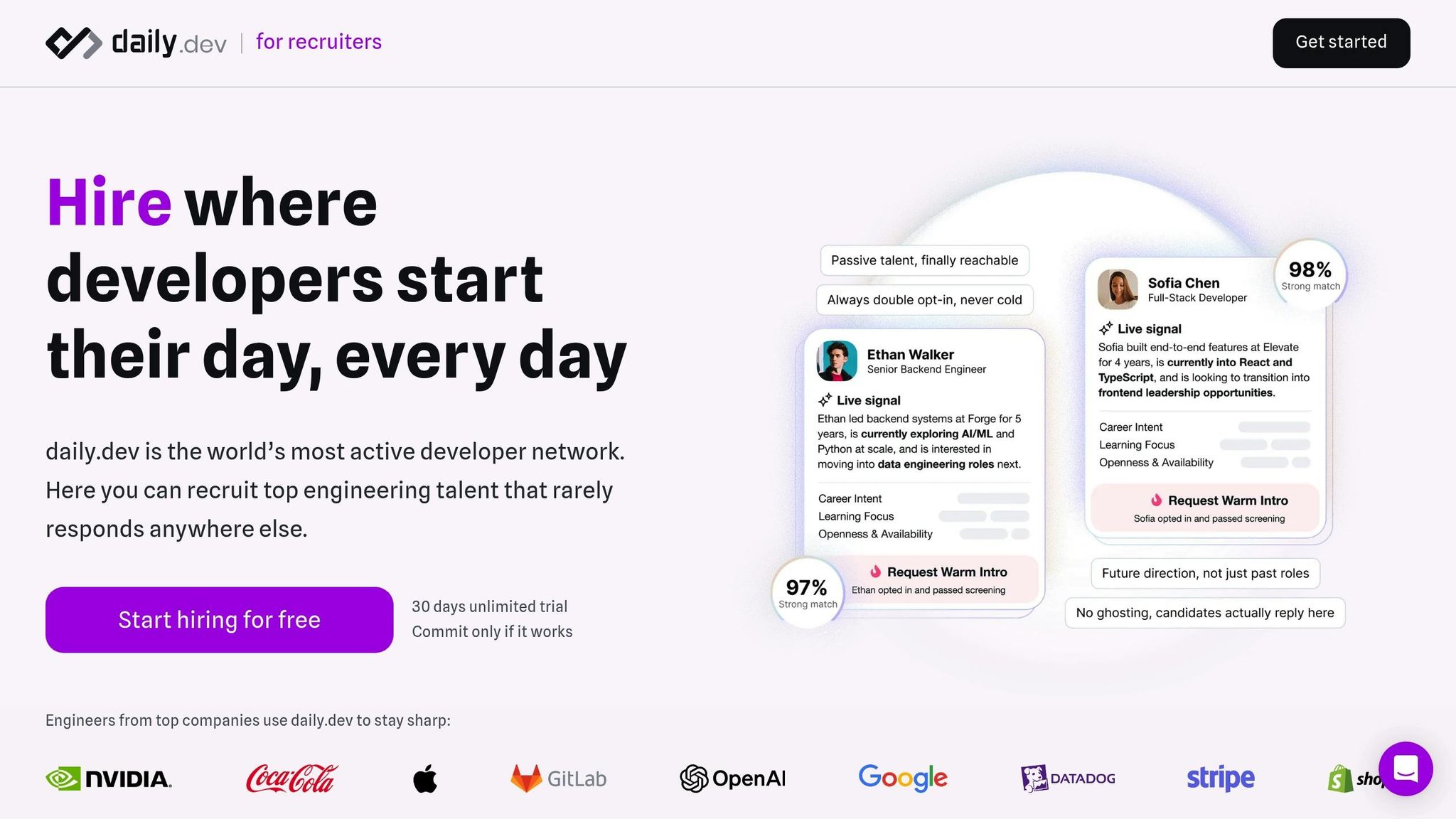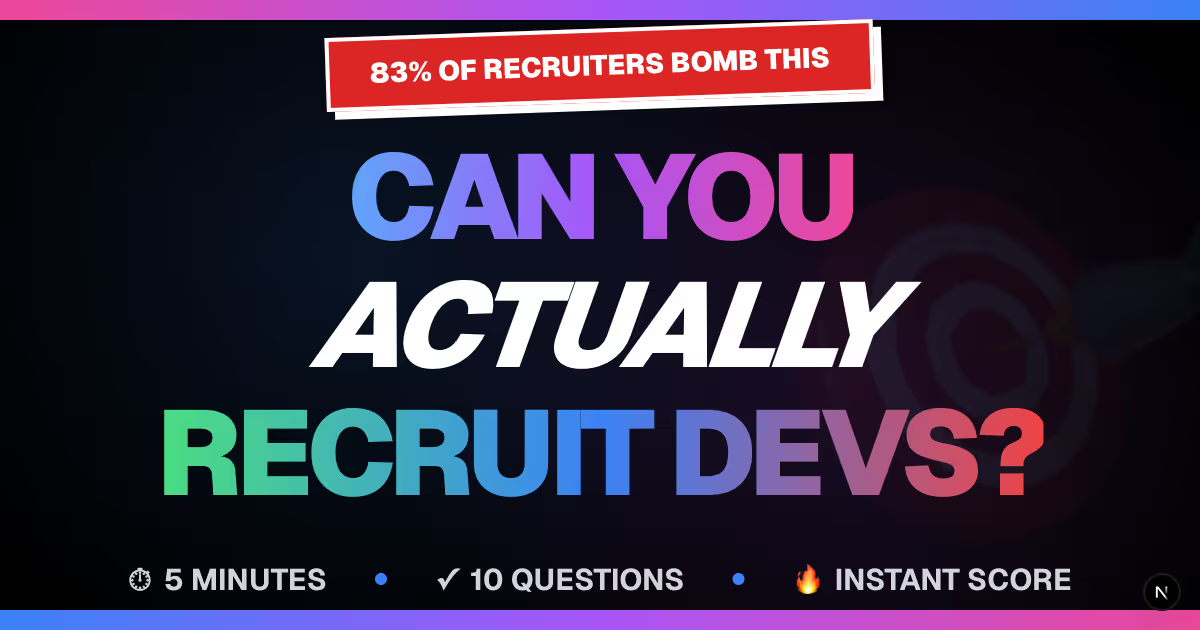


Learn how to choose the right developer hiring platform to streamline your recruitment process, enhance candidate quality, and improve hiring efficiency.
Finding the right developer hiring platform can save you time, money, and frustration. With the growing demand for tech talent - especially in areas like AI - traditional hiring methods often fall short. Developer-focused platforms simplify this process by offering tools like skill assessments, AI-driven matching, and automation to connect you with qualified candidates faster.
Key Takeaways:
- Why It Matters: U.S. tech hiring is competitive, with demand spanning industries like healthcare, finance, and government.
- Challenges: Traditional methods struggle with passive candidates, assessing technical skills, and efficient workflows.
- What to Look For:
- Active Communities: Platforms with engaged developers offer better talent pools.
- Advanced Matching: AI tools and coding tests ensure candidates meet your needs.
- Workflow Integration: Compatibility with ATS, communication tools, and reporting features is essential.
- Global Reach: Access to international talent expands your options.
- Transparent Pricing: Avoid hidden fees; look for pay-per-hire or subscription models.
Example Solution: Platforms like daily.dev Recruiter prioritize meaningful connections through double opt-in systems, active developer communities, and seamless integration with your tools.
Choosing the right platform directly impacts hiring speed, cost, and candidate quality. Focus on features that align with your goals, and track metrics like response rates, time-to-hire, and cost-per-hire to measure success.
What Are Developer Hiring Platforms
Developer Hiring Platform Basics
Developer hiring platforms are specialized online tools designed to connect employers with technical talent, focusing on the unique demands of tech recruitment. Unlike general job boards, these platforms cater specifically to hiring for technical roles.
They come in various forms, including niche freelance platforms, recruitment marketplaces, and systems enhanced with AI. Many modern platforms use AI to streamline the hiring process, offering features like automated candidate vetting and access to a global pool of pre-vetted developers.
When it comes to pricing, these platforms often break away from the traditional recruitment agency model. Instead of charging a percentage of a candidate's annual salary or a fixed fee, many offer subscription-based pricing or charge only upon a successful hire. This flexible pricing structure can be more budget-friendly, especially for companies scaling their tech teams. These tools are designed to create a more efficient, developer-centered hiring process.
However, despite their focus, traditional recruitment challenges still linger.
Common Developer Hiring Challenges
Hiring developers through traditional recruitment methods comes with its own set of obstacles. For one, engaging passive candidates - those who aren't actively job hunting but might be open to the right role - can be tough.
Traditional recruitment often relies on manual workflows: posting jobs, sorting through countless resumes, conducting repetitive interviews, and checking references. This process can feel intrusive to developers, especially when outreach lacks personalization. Recruiters who don’t fully understand technical roles may also struggle to build trust, further complicating the process.
Another significant challenge is assessing technical skills. Standard methods like resume reviews and basic interviews often fail to provide a clear picture of a developer's coding abilities or problem-solving expertise. These issues highlight the need for a more tailored, developer-first approach.
Why Developer-First Platforms Work Better
Developer-first platforms tackle these challenges head-on by meeting developers where they already feel comfortable, rather than trying to pull them into traditional recruitment pipelines. They prioritize transparency and personalization, offering detailed insights about companies, technologies, team dynamics, and project types right from the start.
These platforms often use warm introductions or double opt-in systems, where developers can review role details and choose whether to engage. This eliminates unsolicited outreach, creating a smoother and more respectful candidate experience. On top of that, AI and machine learning ensure better matches by aligning opportunities with a developer's specific skills and interests. The result? Higher-quality connections and better outcomes for both companies and candidates.
How to Evaluate Developer Hiring Platforms
Selecting the right developer hiring platform is a critical step in streamlining your recruitment process and ensuring you attract the right talent. To make the best choice, focus on platforms that align with your hiring goals and make candidate interactions more efficient.
Developer Community Quality and Activity
A platform's developer community plays a major role in determining the quality of candidates you’ll find. Active and engaged communities often attract skilled developers who regularly share insights, participate in discussions, and stay updated on the latest industry trends.
When evaluating a platform, look for signs of active participation. Metrics like the number of daily active users, frequency of comments on technical posts, and the depth of conversations can give you a clear picture of community engagement. Platforms where developers actively contribute - not just browse - are more likely to connect you with high-quality candidates.
Also, assess the range of skill levels within the community. A platform that includes both aspiring junior developers and seasoned professionals creates a balanced ecosystem. This variety ensures you can find candidates for entry-level roles as well as specialized positions, all while benefiting from a thriving, dynamic environment.
Active participation fosters trust, which can lead to higher response rates and more genuine connections with potential candidates.
Candidate Matching and Screening Features
Once you’ve assessed the community's vibrancy, turn your attention to how well the platform matches and screens candidates.
Platforms with advanced matching systems save you time by filtering out irrelevant profiles. AI-driven matching tools are particularly effective, as they go beyond simple keyword searches to analyze technical skills, project experience, and even career goals.
The best platforms incorporate multi-layered screening processes to evaluate both technical expertise and compatibility with your team. Look for features like coding challenges that test practical skills rather than just theoretical knowledge. Some platforms even integrate these assessments into their matching algorithms, ensuring candidates have proven abilities.
Another key factor is behavioral matching. Developers have different working styles, communication habits, and career aspirations. Platforms that account for these softer attributes alongside technical skills provide a fuller picture of each candidate, increasing the likelihood of a successful hire.
Automated tools that verify skills - such as analyzing code repositories, tracking contributions, or gathering peer endorsements - can also give you confidence in a candidate's technical background. A strong matching system should weigh technical abilities, practical assessments, and interpersonal traits to deliver the best possible matches.
Integration with Your Current Workflow
How well a platform integrates with your existing systems can significantly impact your recruitment efficiency. A platform with a flexible API that connects to your applicant tracking system (ATS) can eliminate repetitive tasks, like manual data entry.
Seek out platforms that offer single sign-on (SSO) integration to simplify access for your team while meeting your organization’s security requirements. Additionally, automation features for tasks like candidate outreach, follow-ups, and status updates should work seamlessly with tools your team already uses, such as Slack, Microsoft Teams, or email platforms.
Consider the usability of the platform. A complicated interface requiring extensive training can delay your hiring efforts. Opt for platforms with user-friendly designs and robust onboarding support to help your team get up to speed quickly.
Reporting and analytics tools are another essential feature. Platforms that allow you to export data in compatible formats or provide APIs for custom integrations ensure you can track hiring metrics alongside other recruitment data.
Finally, if your hiring process involves multiple stakeholders, ensure the platform supports collaborative features like role-based access, shared candidate notes, and streamlined approval workflows. This ensures everyone involved in the decision-making process can contribute without disrupting your existing structure.
Platform Features and Success Metrics to Track
After considering the importance of community quality and smooth integration, it’s time to focus on the features and metrics that truly define a platform’s value. These elements help ensure your investment leads to measurable recruitment success.
Global Talent Pool Access
In today’s remote-first world, having access to a global talent pool is non-negotiable. The best platforms connect you with developers across time zones, skill levels, and professional backgrounds.
With advanced filters, you can distinguish between remote, hybrid, and relocation-ready candidates. You can also narrow your search by work authorization status, streamlining visa-related complexities for international hires.
A broader geographic reach often brings diverse skills and perspectives. Developers from different regions may approach challenges in unique ways, offering fresh solutions and varied approaches to technology. To make the most of this diversity, choose a platform that supports effective communication across cultural differences and provides tools for coordinating across time zones.
For recruiters managing global hiring, platforms offering localized support - while maintaining a unified experience - are invaluable. This ensures you can tap into worldwide talent without dealing with fragmented workflows or inconsistent candidate experiences.
Key Performance Metrics to Monitor
Once you’ve assessed the platform’s features, it’s critical to track performance metrics that align with your hiring goals. These indicators provide actionable insights into the platform’s effectiveness.
- Response Rates: High response rates are a strong sign of candidate engagement. If rates are low, it may indicate the need to refine your outreach strategy. Breaking down response rates by role, seniority, or region can uncover trends and areas for improvement.
- Time-to-Hire: Measure the time from first contact to offer acceptance. A shorter time-to-hire means your process is efficient, but breaking this metric into stages - like initial response, screening, interviews, and final decision - can help identify bottlenecks.
- Candidate Quality: Use structured assessments and feedback to ensure that speed doesn’t come at the expense of quality. Tracking how new hires perform during their initial months on the job can validate the platform’s effectiveness.
- Cost-per-Hire: Include all relevant costs, such as platform fees, recruiter hours, and additional expenses like assessments. Comparing these costs to traditional hiring methods helps gauge the platform’s return on investment.
- Candidate Satisfaction: Post-interaction surveys - even for candidates who aren’t hired - can offer valuable feedback. A positive experience strengthens your employer brand and often leads to referrals.
Clear Pricing Models
Transparent pricing in U.S. dollars is crucial to avoid budget surprises. Steer clear of platforms with overly complicated fee structures that make it hard to calculate your actual cost per hire.
Look for pricing models that align with hiring outcomes. For example, pay-per-successful-hire arrangements minimize upfront risk by charging only for placements that meet your criteria.
For companies with steady hiring needs, subscription-based pricing can offer predictable costs. However, it’s essential to monitor these plans to ensure they remain cost-effective over time.
Ask for a detailed fee breakdown before committing to any platform. This helps you identify hidden costs and ensures you know exactly what you’re paying for.
Flexibility in pricing tiers is another key feature to watch for. Platforms that let you scale spending based on hiring volume are ideal for startups experiencing rapid growth or established businesses with seasonal hiring peaks.
Lastly, clear contract terms are a must. Straightforward cancellation policies and performance guarantees, such as trial periods or money-back options, allow you to test the platform’s value without unnecessary risk.
sbb-itb-d1e6221
daily.dev Recruiter: A Developer-First Solution

When choosing a hiring platform, it’s crucial to focus on solutions tailored specifically to the developer community. That’s where daily.dev Recruiter stands out. It takes a developer-first approach, prioritizing meaningful interactions over generic outreach. Here’s a closer look at what makes daily.dev Recruiter excel in community engagement, outreach, and workflow integration.
Powered by an Active Developer Community
daily.dev Recruiter is built on a thriving network of over 1,000,000 developers. This ecosystem is more than just a numbers game - it’s a dynamic space where software engineers actively engage with technical content, stay updated on industry trends, and participate in professional discussions.
The developers on this platform aren’t just passive users; they’re professionals committed to growth. They’re exploring the latest tools, diving into technical topics, and staying sharp in their fields. This means the candidates you connect with are not only qualified but also passionate about their work. Unlike platforms filled with outdated profiles or inactive users, daily.dev Recruiter ensures you’re reaching individuals who are current and deeply engaged in their careers.
Warm Connections, Not Cold Emails
One of the standout features of daily.dev Recruiter is its double opt-in system, which ensures you’re only connecting with developers who have expressed genuine interest in your opportunities. Forget the scattershot approach of spam-heavy cold emails - this platform is all about meaningful, mutual connections.
Here’s how it works: Developers can explore roles that resonate with them and signal their interest. Once they do, a warm introduction is made, creating a starting point for conversations that already feel aligned. This method respects developers’ time and preferences, fostering trust and paving the way for discussions that focus on the role and your company’s culture. It’s a fresh approach that prioritizes quality over quantity, staying true to the developer-first philosophy.
Seamless Integration with Your Workflow
daily.dev Recruiter fits effortlessly into U.S.-based recruitment workflows, making it a practical choice for teams looking to streamline their hiring processes. It supports multi-role management and integrates with popular tools like ATS systems, communication platforms, and scheduling software. This means your recruitment pipeline stays organized and efficient.
Budgeting is straightforward, too. The platform’s transparent pricing model ties costs directly to successful placements, so there’s no guesswork. This predictability makes it easier to demonstrate ROI to leadership and plan recruitment budgets with confidence.
Making Your Final Decision
Choosing the right developer hiring platform boils down to three key factors: the quality of the developer community, the genuineness of connections, and how well the platform fits into your existing workflow. The best platforms treat developers as skilled professionals, not just another resource. Use these criteria to align your hiring strategy with what developers actually value.
Seek out platforms where developers are actively engaged - whether it’s through participating in technical discussions or honing their skills. This kind of involvement often translates to high-quality candidates who are passionate about their work and open to meaningful career opportunities.
"The world's best developer platform for knowledge and community." - daily.dev
Steer clear of generic job boards and impersonal cold outreach that reduce developers to numbers. Instead, opt for platforms offering personalized career opportunities tailored to individual skills and interests.
A double opt-in approach is a must. This ensures that every interaction begins with mutual interest, cutting down on wasted time and irrelevant conversations. When developers are given the freedom to explore opportunities at their own pace and show genuine interest, it creates trust right from the start.
Platforms that prioritize candidates in this way also pave the way for a hiring process that’s both cost-effective and straightforward. Look for transparent pricing models with a clear return on investment. Platforms that tie costs to successful hires make it easier to demonstrate value to stakeholders and keep recruitment budgets predictable. Avoid those with hidden fees or overly complicated pricing structures that can make planning a headache.
Finally, make sure the platform integrates smoothly with your existing tools - whether it’s your ATS, scheduling software, or communication channels. Let these insights guide your final decision as you evaluate your options.
FAQs
What are the main advantages of using a developer hiring platform instead of traditional recruitment methods?
Using a developer hiring platform comes with several advantages compared to traditional recruitment methods. These platforms let you evaluate candidates on a larger scale through real-world coding challenges, which are automatically scored. This approach makes the hiring process more data-focused and less dependent on personal opinions.
Another key benefit is their ability to minimize bias by relying on objective, research-based skill assessments, creating a more equitable evaluation process. Beyond that, these platforms simplify workflows, helping you identify top developers more efficiently while improving the overall quality of hires. Many organizations have reported cutting their time-to-hire by up to 25%, saving both time and resources while accelerating the growth of their teams.
How can I evaluate the quality and engagement of a developer community on a hiring platform?
To assess the strength and involvement of a developer community on a hiring platform, start by observing the level of active participation. Key indicators include frequent discussions, collaborative problem-solving, and meaningful contributions from members - these are clear signs of a thriving and engaged community.
Also, take note of features such as mentorship programs, community events, and platforms that encourage developers to share insights or pitch ideas. These activities often build trust and create valuable connections among members. Lastly, evaluate how regularly members contribute and the quality of their interactions to get a clearer picture of the community’s overall health and engagement.
What key features should I look for in a developer hiring platform to ensure it works seamlessly with my recruitment process?
To make sure a developer hiring platform fits seamlessly into your recruitment process, prioritize essential features like strong APIs, built-in integrations, and flexible endpoints. These tools enable smooth data sharing - such as candidate profiles, test results, and job listings - cutting down on manual tasks and boosting overall efficiency.
It’s also important to choose platforms that support secure authentication methods like OAuth 2.0, ensuring sensitive data stays protected. Platforms offering pre-built connectors or low-code integration options can simplify the setup process and lower the effort needed for ongoing maintenance. These capabilities help the platform work seamlessly with your current HR systems, streamline operations, and improve collaboration across your team.
Related Blog Posts








